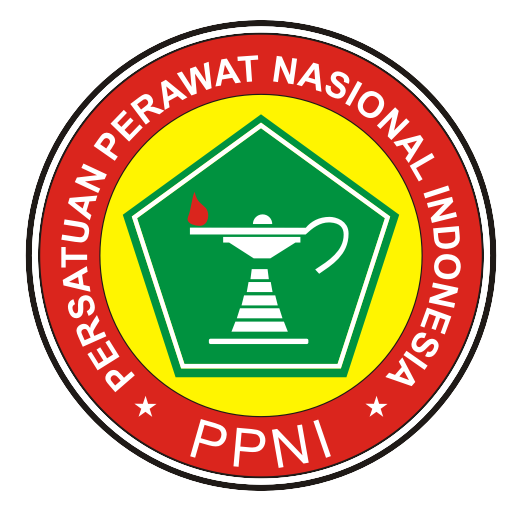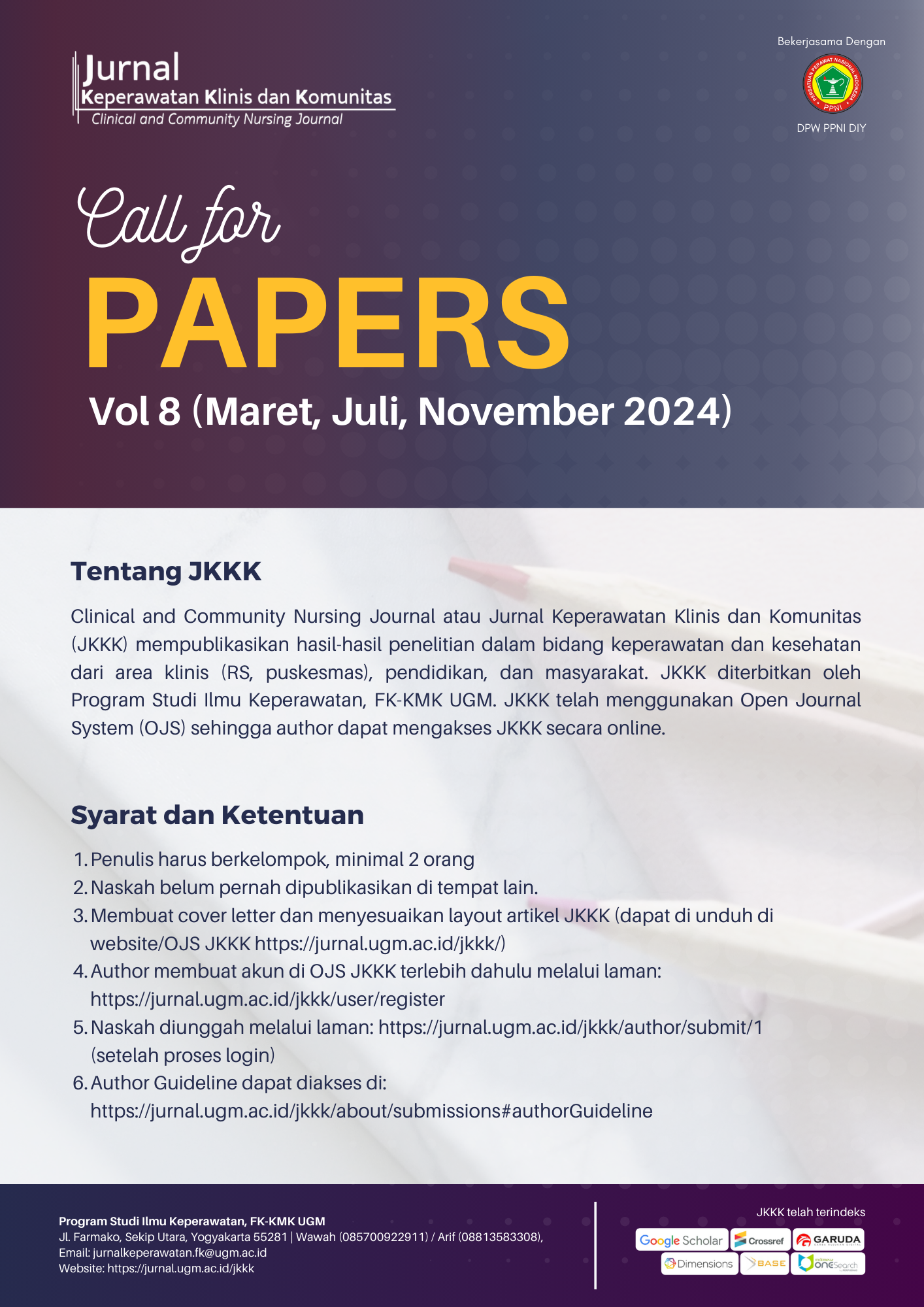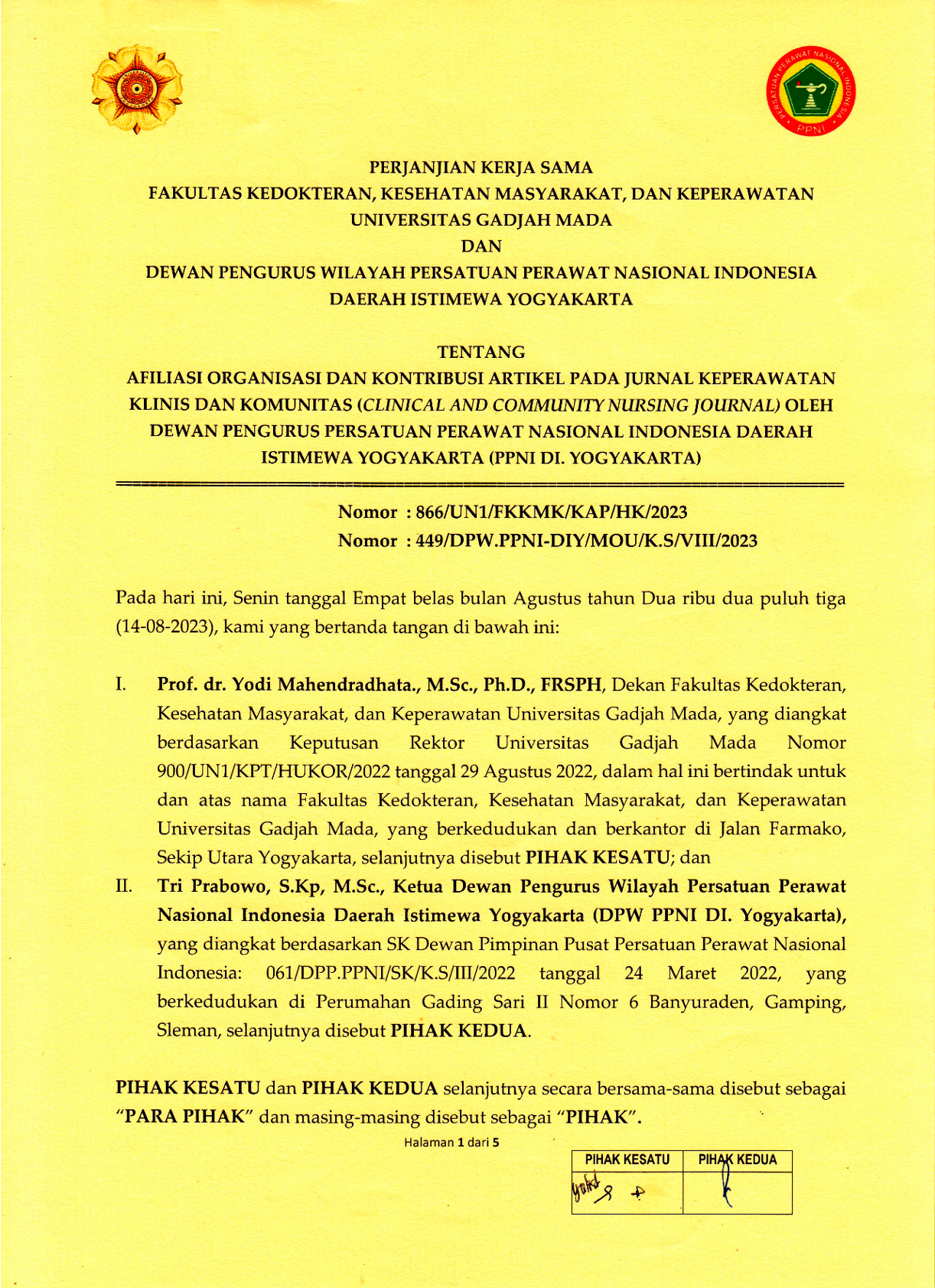Manajemen Syok Hipovolemia pada Pasien Fraktur Patologis Neck-Femur Suspek Metastasis dengan Hemiarthroplasty: Studi Kasus
Retnaningsih Retnaningsih(1*), Arifin Triyanto(2), Tri Subekti(3)
(1) Program Studi Ilmu Keperawatan, Fakultas Kedokteran, Kesehatan Masyarakat, dan Keperawatan, Universitas Gadjah Mada
(2) Departemen Keperawatan Medikal Bedah, Fakultas Kedokteran Kesehatan Masyarakat dan Keperawatan, Universitas Gadjah Mada
(3) Instalasi Kamar Bedah dan Anestesi Rumah Sakit Umum Pusat Dr. Sardjito Yogyakarta
(*) Corresponding Author
Abstract
Background: Hemiarthroplasty in a pathological neck-femur fracture of suspected Metastatic Bone Disease (MBD) case, increases the risk of intraoperative bleeding and hypovolemic shock. Case studies related to this phenomenon are scarce.
Objective: Describe the management of hypovolemic shock in pathological neck-femur fracture patient with MBD suspect which was followed by hemiarthroplasty action.
Case Report: A 59-year-old woman experienced bleeding of 1,000-1,300 cc during surgery, causing shock with low blood pressure, tachycardia, and cold acral. Management of hypovolemic shock during surgery included fluid resuscitation, administration of vasopressors, blood transfusion, and administration of tranexamic acid.
Outcome: Hypovolemic shock management course of action was include hemodynamic and coagulation management, with the collaboration of a team of nurses and doctors. The role of instrument, circular, and anesthesia nurses was crucial to maintain patient stability during surgery. After being given management intervention hypovolemic shock, the patient's response to resuscitation therapy was in a fast category so that the shock was quickly resolved and the operation could be continued until completion.
Conclusion: Monitoring and rapid treatment of shock in pathological neck-femur fracture patient with MBD suspect which is followed by hemiarthroplasty action, including intraoperative bleeding, can prevent morbidity and mortality.
INTISARI
Latar belakang:Hemiarthroplasty pada fraktur patologis neck-femur suspek Metastatic Bone Disease (MBD) meningkatkan risiko perdarahan intraoperatif dan syok hipovolemia. Studi kasus terkait hal ini masih jarang ditemukan.
Tujuan: Mendeskripsikan tata laksana manajemen syok hipovolemia pada pasien fraktur patologis neck-femur suspek mengalami MBD untuk kemudian mendapatkan tindakan hemiarthroplasty.
Laporan kasus: Wanita 59 tahun mengalami perdarahan 1.000-1.300 cc selama operasi, menyebabkan syok dengan tekanan darah rendah, takikardi, dan akral dingin. Manajemen syok hipovolemia selama operasi, meliputi resusitasi cairan, pemberian vasopressor, transfusi darah, dan pemberian asam traneksamat.
Hasil:Tindakan manajemen syok hipovolemia meliputi manajemen hemodinamik dan koagulasi, dengan kolaborasi tim perawat dan dokter. Peran perawat instrumen, sirkuler, dan anestesi penting untuk menjaga stabilitas pasien selama operasi. Setelah diberikan intervensi manajemen syok hipovolemia, respons pasien terhadap terapi resusitasi termasuk katagori cepat, sehingga syok segera teratasi dan operasi dapat dilanjutkan sampai selesai.
Simpulan:Monitoring dan penanganan syok secara cepat pada pasien fraktur patologis neck-femur yang dilakukan tindakan hemiarthroplasty dengan perdarahan intraoperatif dapat mencegah morbiditas dan mortalitas.
Keywords
Full Text:
PDFReferences
Dewi DAK, Wiratnaya GE, Setiawan GB. Prevalensi Metastatic Bone Disease (MBD) Berdasarkan Umur, Lokasi, dan Tumor Primer di RSUP Sanglah/FK UNUD Periode 2013-2017. Jurnal Medika Udayana. 2019;8(8). https://ojs.unud.ac.id/index.php/eum.
Axelrod D, Gazendam AM, Ghert M. The Surgical Management of Proximal Femoral Metastases: A Narrative Review. Curr Oncol. 2021; 28(5): 3748–3757. https://doi.org/10.3390/curroncol28050320.
Rosas S, Physician Scientist R, Marquez-Lara A, Scientist P, Jinnah AH, Roche MW, et al. Hemiarthroplasty for Fractures of Metastatic Bone Disease have Different Outcomes Compared to Fractures without Metastasis: A Matched-Pair Analysis. Surg Technol Int. 2017; 22(31): 339-345. https://www.ncbi.nlm.nih.gov/pmc/articles/PMC6391979/.
Cui YP MCWB. Perioperative Clinical Characteristics of Patients with Pathological Fracture of Proximal Femur. PubMed. 2019; 51(5): 875-880. https://doi.org/10.19723/j.issn.1671-167X.2019.05.014.
Lim CY, Mat-Hassan S, Awang M, Md-Ariff MF, Hau Abdullah MA. Modified Unipolar Hemiarthroplasty for The Treatment of Metastatic Lesions of Proximal Femur with Pathological Fractures: Case Series of Six Patients. Malaysian Orthop J. 2019; 13(3): 21–27. https://doi.org/10.5704%2FMOJ.1911.004.
Hayat Z, Tiwari V, Varacallo M. Surgical Management of Femoral Neck Fractures. Treasure Island (FL), Florida: StatPearls Publishing; 2024.
Lucas B, Riebau C, Mohr J, Pliske G, Walcher F, Piatek S. Effect of 4DryField® PH on Blood Loss in Hip Bipolar Hemiarthroplasty Following Intracapsular Femoral Neck Fracture – A Randomized Clinical Trial. BMC Musculoskelet Disord. 2021; 22(113): 1–7. https://doi.org/10.1186/s12891-021-03983-6.
Hooper N, Armstrong TJ. Hemorrhagic Shock Continuing Education Activity. Treasure Island (FL), Florida: StatPearls Publishing; 2024.
Rahardjo S, Uyun Y, Budianti N. Manajemen Preoperatif Kehamilan Ektopik Terganggu dengan Syok Hipovolemia. Jurnal Komplikasi Anestesi. 2018; 5(1): 31-42. https://doi.org/10.22146/jka.v5i1.7320.
Taghavi, Aussama, Askari. Hypovolemic shock. Vet Clin North Am. 1976; 6(2): 187-192.
Dudley AC, Griffioen AW. Pathological Angiogenesis: Mechanisms and Therapeutic Strategies. Angiogenesis. 2023; 26(3): 313-347. https://doi.org/10.1007/s10456-023-09876-7.
Wiznia D, Melegrito R. Bipolar Hip Hemiarthroplasty_What is it and What to Expect [homepage on the internet]. c.2022. [Updated 22 Jun 22; cited 20 Jul 24]. Available from https://www.medicalnewstoday.com/articles/bipolar-hemiarthroplasty.
Alqunai MS, Alshammary RH, Almuhaysin AS, Alsubayti RA, Alsharari A jadid, Alanazi JM, et al. Intraoperative Bleeding Management: An Updating Literature Review: Review Article. J Pharm Res Int. 2021; 16: 745–753. https://doi.org/10.9734/jpri/2021/v33i59A34324.
Rusydi MAR, Tua IJM, Magdaleni AR. Hubungan Kadar Hemoglobin Sebelum Operasi dengan Kebutuhan Transfusi Sel Darah Merah Intraoperatif pada Pasien Bedah Pintas Arteri Koroner di RSUD Abdul Wahab Sjahranie Samarinda. J Sains dan Kesehatan. 2022; 4(2): 155–160. https://jsk.farmasi.unmul.ac.id/index.php/jsk/article/download/928/361/2547.
Wied C, Tengberg PT, Holm G, Kallemose T, Foss NB, Troelsen A, et al. Tourniquets Do Not Increase The Total Blood Loss or Reamputation Risk in Transtibial Amputations. World J Orthop. 2017; 8(1): 62–7. https://doi.org/10.5312%2Fwjo.v8.i1.62.
Manta N, Mangiavini L, Balbino C, Colombo A, Pandini EG, Pironti P, et al. The Role of Suction Drainage in The Management of Perioperative Bleeding in Total and Unicomcompartmental Knee Arthroplasty: A Retrospective Comparative Study. BMC Musculoskelet Disord. 2021; 22(1): 1-6. https://doi.org/10.1186/s12891-021-04868-4.
Shah A, Palmer AJR, Klein AA. Strategies to Minimize Intraoperative Blood Loss during Major Surgery. British Journal of Surgery. 2020; 107(2): 26–38. https://doi.org/10.1002/bjs.11393.
El-Sedfy A, Chamberlain RS. Surgeons and Their Tools: A History of Surgical Instruments and Their Innovators. Part V: Pass Me The Hemostat/Clamp. Am Surg. 2015 Mar; 81(3): 232-238. https://pubmed.ncbi.nlm.nih.gov/25760197.
Cordero I. Electrosurgical units - How They Work and How to Use Them Safely. Community Eye Heal J. 2015; 28(89): 15–6. https://www.ncbi.nlm.nih.gov/pmc/articles/PMC4579996/pdf/jceh_28_89_15.pdf.
Subagiarta I made, Adisthayana S. Terapi Oksigen [homepage on the internet]. c. 2016. [updated 2016; cited 2024]. Available from https://erepo.unud.ac.id/id/eprint/8864.
Saputra DN, Rahman A, Sutanto B. Tatalaksana Syok Hipovolemik pada Perdarahan Intra-abdominal. Proceeding B Natl Symp Work Contin Med [homepage on the internet]. c. 2021. [updated 2021; cited 2024]. Available from https://publikasiilmiah.ums.ac.id/xmlui/handle/11617/12785.
Statler AK, Maani C V, Kohli A. Ephedrine. Treasure Island (FL), Florida: StatPearls Publishing; 2023.
Gaol, Tanto C, Pryambodho. Terapi Cairan. Kedokteran. Jakarta: Media Aesculapius; 2018.
Curnow J, Pasalic L, Favaloro E. Why Do Patients Bleed? Surg J. 2016; 2(1): 29–43. https://doi.org/10.1055%2Fs-0036-1579657.
Ockerman A, Vanassche T, Garip M, Vandenbriele C, Engelen MM, Martens J, Politis C, Jacobs R, Verhamme P. Tranexamic Acid for The Prevention and Treatment of Bleeding in Surgery, Trauma and Bleeding Disorders: A Narrative Review. Thromb J. 2021; 19(1): 1-16. https://doi.org/10.1186/s12959-021-00303-9.
Henry S. ATLS 10th Edition Offers New Insights into Managing Trauma Patients | The Bulletin. Bull Am Coll Surg [Homepage on the internet]. c.2018. [updated 1 Jun 2018; cited 20 Jul 2024]. Available from https://bulletin.facs.org/2018/06/atls-10th-edition-offers-new-insights-into-managing-trauma-patients.
Article Metrics
Refbacks
- There are currently no refbacks.
Copyright (c) 2024 Retnaningsih Retnaningsih, Arifin Triyanto, Tri Subekti

Jurnal Keperawatan Klinis dan Komunitas (Clinical and Community Nursing Journal)
collaborates with DPW PPNI DIY
![]()
Jurnal Keperawatan Klinis dan Komunitas (Clinical and Community Nursing Journal) is licensed under a Creative Commons Attribution-ShareAlike 4.0 International License.




